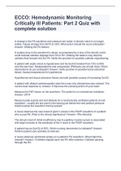Hemodynamic monitoring - Study guides, Class notes & Summaries
Looking for the best study guides, study notes and summaries about Hemodynamic monitoring? On this page you'll find 2695 study documents about Hemodynamic monitoring.
Page 3 out of 2.695 results
Sort by
ECCO: Hemodynamic Monitoring Critically Ill Patients: Part 2 Quiz with complete solution
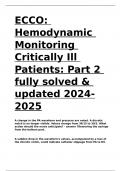
-
ECCO: Hemodynamic Monitoring Critically Ill Patients: Part 2 fully solved & updated 2024-2025
- Exam (elaborations) • 6 pages • 2024
-
- $14.49
- + learn more
A change in the PA waveform and pressure are noted. A dicrotic notch is no longer visible. Values change from 36/15 to 30/3. What action should the nurse anticipate? ?Removing the syringe from the balloon port. A sudden drop in the waveform's values, accompanied by a loss of the dicrotic notch, could indicate catheter slippage from PA to RV. Inflating the balloon may help the catheter float forward into the PA. Notify the provider for possible catheter repositioning. A patient with s...
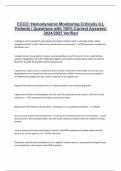
-
ECCO: Hemodynamic Monitoring Critically ILL Patients | Questions with 100% Correct Answers| 2024/2025 Verified
- Exam (elaborations) • 4 pages • 2024
-
- $7.99
- + learn more
A change in the PA waveform and pressure are noted. A dicrotic notch is no longer visible. Values change from 36/15 to 30/3. What action should the nurse anticipate? - ?Removing the syringe from the balloon port. A sudden drop in the waveform's values, accompanied by a loss of the dicrotic notch, could indicate catheter slippage from PA to RV. Inflating the balloon may help the catheter float forward into the PA. Notify the provider for possible catheter repositioning. A patient with sept...
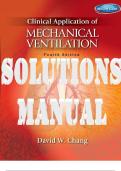
-
SOLUTIONS MANUAL for Clinical Application of Mechanical Ventilation 4th Edition by Chang David. ISBN 9781285667348 (All Chapters 1-18). _Answers to Workbook Questions
- Exam (elaborations) • 203 pages • 2023
- Available in package deal
-
- $34.74
- 1x sold
- + learn more
SOLUTIONS MANUAL for Clinical Application of Mechanical Ventilation 4th Edition by Chang David. ISBN 7348 (All Chapters 1-18). TABLE OF CONTENTS Chapter 1: Principles of Mechanical Ventilatio n Chapter 2: Effects of Positive Pressure Ventilation Chapter 3: Classification of Mechanical Ventilators Chapter 4: Operating Modes of Mechanical Ventilation Chapter 5: Special Airways for Ventilation Chapter 6: Airway Management in Mechanical Ventilation Chapter 7: Noninvasive Positive Pressure Ventilatio...
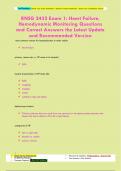
-
RNSG 2432 Exam 1: Heart Failure, Hemodynamic Monitoring Questions and Correct Answers the Latest Update and Recommended Version
- Exam (elaborations) • 42 pages • 2024
-
- $13.49
- + learn more
most common reason for hospitalization in older adults heart failure primary reason pts w/ HF come in to hospital SOB typical presentation of HF looks like SOB coughing tiredness ascites swelling in legs and ankles define heart failure Clinical syndrome that can result from any structural or functional cardiac disorder that impairs the hearts ability to fill with or eject blood. categories of HF left or right sides diastolic or systolic acute or chronic TestTra...
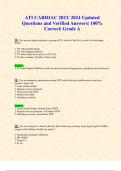
-
ATI CARDIAC 2023/ 2024 Updated Questions and Verified Answers| 100% Correct| Grade A
- Exam (elaborations) • 34 pages • 2023
- Available in package deal
-
- $11.49
- 1x sold
- + learn more
ATI CARDIAC 2023/ 2024 Updated Questions and Verified Answers| 100% Correct| Grade A Q: You are providing teaching to a group of PTs which of the Pts is at risk for developing PAD? 1. PT with hypothroidism 2. PT with Diabetes Mellitus 3. PT whose daily diet consists of 25% fat 4. Pt who consumes 2 bottles of beer a day Answer: 2. PT with Diabetes Mellitus-at risk for microvascular and progressive peripheral arterial disease Q: You are planning a presentation about HTN which...

-
Hemodynamic Monitoring Exam Guide| Questions with Complete Solutions
- Exam (elaborations) • 4 pages • 2024
- Available in package deal
-
- $12.49
- + learn more
Levels of hemodynamic monitoring - Arterial, Central Venous, Pulmonary Artery Pulmonary Artery Catheter - Allows for monitoring of vascular tone, myocardial contractility, intracardiac pressures, cardiac output, and fluid balance. Arterial line - Usually placed in radial or femoral arteries, allows continuous BP monitoring and rapid recognition of problems requiring intervention. CVP/RAP - Central Venous Presssure or Right Atrial Pressure: Measured in the great veins/right atrium, it is a ...
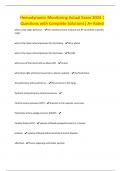
-
Hemodynamic Monitoring Actual Exam 2024 | Questions with Complete Solutions| A+ Rated
- Exam (elaborations) • 6 pages • 2024
- Available in package deal
-
- $12.49
- + learn more
what is end organ perfusion - the needed amount of blood and BP to perfuse a specific organ what is the mean arterial pressure for the kidney - 60 or above what is the mean arterial pressure for the braain - 80-100 what area of the hearts tells us about JVD - atrium what does right arterial pressure tell us about a patient - the fluid status
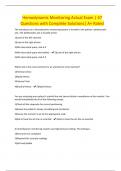
-
Hemodynamic Monitoring Actual Exam | 47 Questions with Complete Solutions| A+ Rated
- Exam (elaborations) • 8 pages • 2024
-
- $12.49
- + learn more
The transducer on a hemodynamic monitoring system is leveled to the patient's phlebostatic axis. The phlebostatic axis is located at the: 1)Level of the left ventricle 2)Level of the right atrium 3)4th intercostal space, mid A-P 4)4th intercostal space mid-axillary - 2)Level of the right atrium 3)4th intercostal space, mid A-P Which site is the most common for an arterial line to be inserted? 1)Femoral artery 2)Radial Artery 3)Femoral Vein 4)Brachial Artery - 2)Radial Artery
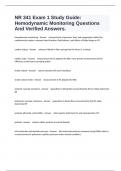
-
NR 341 Exam 1 Study Guide: Hemodynamic Monitoring Questions And Verified Answers.
- Exam (elaborations) • 3 pages • 2024
-
- $9.49
- + learn more
hemodynamic monitoring - Answer measurement of pressure, flow, and oxygenation within the cardiovascular system. assesses heart function, fluid balance, and effects of fluids/drugs on CO cardiac output - Answer volume of blood in liters pumped by the heart in 1 minute cardiac index - Answer measurement of CO adjusted for BSA, more precise measurement of the efficiency of the heart's pumping action stroke volume - Answer volume ejected with each heartbeat stroke volume in...

How did he do that? By selling his study resources on Stuvia. Try it yourself! Discover all about earning on Stuvia

